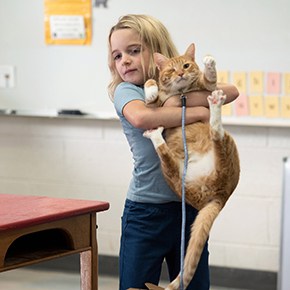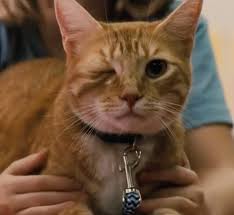What Writers Can Learn from Fred the One-Eyed Cat
Today I want to talk about a one-eyed orange tabby cat named Fred. Some of you are saying, “Oh, yeah, I LOVE Fred!” And others are saying, “Uh . . . Fred who?”
Why should I spend time blogging about Fred? Is he some famous kitty? A character in great literature? No, quiet (well, he does meow) Fred is just a cat who has a role in the terrific movie Gifted.
But not just any role. Some might argue that Fred is a secondary character in the story, and while that may be true, he is actually a carefully crafted plot device for the story. And that’s why I’m bringing him up in this post.
While he rightly is a participant in what could be labeled accurately as a literal and iconic “pet the cat” (or “save the cat”) moment, he has a much more important part to play in Gifted.
 Great stories, whether novels or movies or plays, bring in special elements that help reveal important things in the story. Let’s take a look at Gifted and we’ll examine Fred’s key part. The reason being: I want you to think about adding something like Fred to your novel. Why? Because it will enrich your story a thousandfold, and it will help readers bond with your protagonist.
Great stories, whether novels or movies or plays, bring in special elements that help reveal important things in the story. Let’s take a look at Gifted and we’ll examine Fred’s key part. The reason being: I want you to think about adding something like Fred to your novel. Why? Because it will enrich your story a thousandfold, and it will help readers bond with your protagonist.
Gifted is the story about seven-year-old Mary Adler, who is a genius. This movie is worth spending time deconstructing because its structure is perfect.
Inciting incident? Mary is happily being home-schooled by her uncle Frank, who has raised her since his sister committed suicide (when Mary was a baby). But now it’s time for Mary to have that normal life her mother wished for her to have, and that means going to first grade like all the other kids her age.
But Mary does not want to go. She’s got an attitude, she’s feisty, she’s opinionated, and she does not suffer fools—and most of the people around her fit that description, in her eyes. She is smarter than practically anyone else on earth.
While Frank has tried to raise her right, teach her humility and manners, Mary just can’t get with the program, though her defiance and snarky remarks are adorable and endearing (to viewers, not those around her).
Sure enough, the first day of school is a disaster, as she complains about how stupid it is to learn single-digit addition, and her teacher starts throwing harder and harder math problems at her. And this of course leads to opening the Pandora’s box.
This movie is about a custody battle between Frank, who never bothered to get legal custody of Mary, and Mary’s grandmother, whose insatiable quest for fame and glory (for herself vicariously through her daughter) pushed Mary’s mother to kill herself. No wonder Frank moved away and cut off all ties to Evelyn.
But Evelyn soon shows up and wants to fast-track little Mary to the fame that Mom failed to garner due to her untimely death. And what ensues is a tense, heart-aching fight that hurts Mary deeply.
I’m not going to give the entire story synopsis here. Watch the movie; you’ll love it. But let’s look at a few key things.
The goal is set at the quarter mark, as it should be: Mark will fight to not only keep Mary but to give her a normal kid’s life. He does not want Evelyn to take Mary away, to some school for math geniuses, but Evelyn is rich and Frank is poor. And it’s not hard to see how Evelyn might get the upper hand, and she does she really nasty devious things that hurt her granddaughter. But she doesn’t care. All she cares about is that Mary one day might solve the Millennium Prize problem her mother worked on feverishly and seemingly never solved.
Sorry, but the following CONTAINS SPOILERS, so please watch the movie before you go on.
How Fred Is Important to the Story Structure
At the climax, after losing Mary in the court battle (she is moved to a foster home), enter Fred.
We see Fred throughout the movie. He is a pretty cool cat, and Mary loves him. We see her affection for Fred. We see that the only time early on in Mary’s rough adjustment to school, when she lets down her guard and her attitude, is when she brings Fred for Show and Tell.
Here we get a glimpse of Mary’s “true essence” when she shares Fred with the class, sounding just like an ordinary kid. Imagine that.
While the protagonist of a novel is the one to move from persona to essence, from showing the prepared face to the world to keep “safe” and moving to accepting and embracing his or her true identity, Mary is the one who undergoes this transformation.
We don’t see Frank change much. He’s the devoted caregiver all the way through, and he holds his ground, though he is battered and nearly beaten by the vicious Evelyn.
But Mary truly wants to come into her essence. To be a girl, one like everyone else, and her anger and frustration and other issues are all tied up with this truth.
So what’s the point here with Fred? Here are the key elements of the story that involve Fred. The screenwriter, Tom Flynn, carefully used Fred as a device to accomplish many things in this story.
First, the obvious: Fred represents normal childhood, which is the goal for both Mary and Frank. When Mary is playing with Fred or showing him off to the classroom, she forgets she’s a genius, that she doesn’t fit in anywhere, that she has no friends. So Fred is both a lifeline to normal life and sanity as well as a great comfort for her loneliness (and we cat lovers get this through and through).
Fred also represents something deeper. He’s different from all other cats. He has a “handicap,” just as Mary does—she is so smart that it emotionally and socially handicaps her. She is an outcast, and Fred, if he lived in a cat society that mirrored heartless human society, would also be treated as an outcast. The two “outcasts” find comfort in each other.
Second: Flynn sets up right away that evil Evelyn is allergic to cats. She won’t come in the house, and though we think it’s an excuse because she thinks Frank’s house is sub-par squalor (it’s not), the important fact of Evelyn’s allergies is set up. Pay attention, writers.
Third: Flynn uses the allergy as the vehicle for Frank to expose Evelyn’s treachery because, when all hope is lost for Frank, he’s shown an adoption poster of Fred (and he’s easily recognizable by that missing eye) that is distributed after Mary moves into the foster home with Fred. Frank immediately realizes what Evelyn is up to: she’s set up the whole foster home gig in order to co-opt Mary for her purposes, which is nothing less than controlling Mary’s future and putting the same suicide-inducing stress upon her as she had Mary’s mom.
Frank rescues Fred at the climax of the movie, literally saving the cat from being euthanized at the eleventh hour. And I mean 11:59, because Fred is in the cage and the syringe of death is on the metal tray, about to be picked up by the person in the white coat and its contents administered to Fred to send him off to kitty heaven.
 Frank gets his “save the cat” moment as we see him barreling into the exam room and rushing out with not just Fred in his cage but two other kitties about to meet their horrible untimely demise. Yay, Frank!
Frank gets his “save the cat” moment as we see him barreling into the exam room and rushing out with not just Fred in his cage but two other kitties about to meet their horrible untimely demise. Yay, Frank!
Now that it’s clear Evelyn broke the law and the order of the court, Frank storms into the foster home and confronts her. Through some painful next scenes that I won’t go into here (I hope you’ve watched this movie by now), Frank gets Mary back, gets Evelyn off his back for good, and gives Mary that normal childhood she’s longed for, while also using her math prowess to help solve the world’s math problems.
So What Can Writers Learn from Fred?
Fred could have been left out of the story and it still would have worked. We could have seen Mary doing other things that show her wanting to be a normal kid. We could have learned of Evelyn’s treachery some other way.
But when you create an object, some thing that is important to your character, it can serve as a symbol. Symbols are very powerful. Fred the cat is a symbol of normal life, of a home filled with love, of all that is sweet and wonderful and furry and cuddly. He is safety and comfort, and Frank is rescuing all that Fred stands for when he rescues Fred.
So, think about using something symbolic in your story to help drive home your themes. In Colorado Promise, the first installment in my historical Western romance series, I very deliberately came up with a symbol for my protagonist. She loves botany and dreams of going to college. But when she’s forced to move with her family to Colorado, she takes a potted crepe myrtle plant with her. It becomes a symbol of her trying to adjust to a new environment, and the plant is mentioned in key places, along with the motif that those who moved out West learned to “bloom where they’re planted.”
At the end of the book, after all the hardships and obstacles and finally winning the heart of the cowboy she’s in love with, she plants the tree in the spring, with the hope it will thrive. We see Emma, after much struggle, not only accept her new life in Colorado but thrive as we see she is truly planted.
I try to come up with a motif or symbol for every one of my novels, and I’ve written a bit about motifs in my craft books (see the chapter devoted to motifs in The 12 Key Pillars of Novel Construction).
And don’t forget how Fred was used as a clever plot element. It’s through Fred that Frank gets his daughter back.
Think of the symbolism inherent in Evelyn being allergic to cats. If “cats” represents normal, healthy life for Mary, it stands to reason Evelyn would find Fred an anathema, for she is “allergic” to the idea of a normal life for Mary. Make sense? Evelyn tries to destroy that “normal life” (read: kill the cat), but it serves as her downfall.
I hope you’ve learned some cool things from Fred. Are you ready to come up with an awesome symbol or motif for your story? Can you think of another movie or novel in which an element is used in a symbolic way to great effect?












Really enjoyed this. I don’t keep up with all your posts (sadly), but Fred grabbed me and so happy to partake in this writer’s purrnography. Can’t wait to see the movie, especially knowing the end. Thank you for this dissection and insight into symbols.
No kidding, this is a great post! Thanks so much for decoding the story points and symbols in this film. I truly need to see it. As always, thanks for all you do to assist writers. I’ve shared this post online. All best to you!
I think this is a great post, even more so because I’m real Fred’s mom! Fred in “Gifted” is based on our real cat Fred. His Facebook page is https://www.facebook.com/fred.oneeyedcat – you can keep up with his antics and handsome face!
How cool is that? Thanks for sharing. I hope you enjoyed the post featuring the kitty! I had a one-eyed cat too named Cupcake.